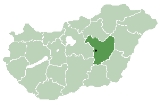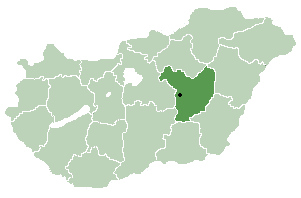
Tiszaroff
Encyclopedia

Village
A village is a clustered human settlement or community, larger than a hamlet with the population ranging from a few hundred to a few thousand , Though often located in rural areas, the term urban village is also applied to certain urban neighbourhoods, such as the West Village in Manhattan, New...
in Jász-Nagykun-Szolnok
Jász-Nagykun-Szolnok
This article is about the modern county, for the historical one see Jász-Nagykun-Szolnok .Jász-Nagykun-Szolnok is the name of an administrative county in Hungary. It lies in central Hungary and shares borders with the Hungarian counties Pest, Heves, Borsod-Abaúj-Zemplén, Hajdú-Bihar, Békés,...
county, in the Northern Great Plain
Northern Great Plain
Northern Great Plain is a statistical region of Hungary. It is part of Great Plain and North region. Northern Great Plain includes the counties of Hajdú-Bihar, Jász-Nagykun-Szolnok, and Szabolcs-Szatmár-Bereg. It is also one of the largest plains in the world with an area of about 3000 square...
region
Region
Region is most commonly found as a term used in terrestrial and astrophysics sciences also an area, notably among the different sub-disciplines of geography, studied by regional geographers. Regions consist of subregions that contain clusters of like areas that are distinctive by their uniformity...
of central Hungary
Hungary
Hungary , officially the Republic of Hungary , is a landlocked country in Central Europe. It is situated in the Carpathian Basin and is bordered by Slovakia to the north, Ukraine and Romania to the east, Serbia and Croatia to the south, Slovenia to the southwest and Austria to the west. The...
.
Geography
It covers an areaArea
Area is a quantity that expresses the extent of a two-dimensional surface or shape in the plane. Area can be understood as the amount of material with a given thickness that would be necessary to fashion a model of the shape, or the amount of paint necessary to cover the surface with a single coat...
of 52.49 km² (20 sq mi) and has a population
Population
A population is all the organisms that both belong to the same group or species and live in the same geographical area. The area that is used to define a sexual population is such that inter-breeding is possible between any pair within the area and more probable than cross-breeding with individuals...
of 1905 people (2002).
History of the Tiszaroff Reformed Church
More than three hundred years ago Tiszaroff was located to the North about 3 km (2 mi) from the present location. Its church building was made of "weaved rod and mud" called "patics" [potits]. It had been repaired in 1713. Because of the flood of the Tisza river the whole village had moved out to its present location. In 1726 Mihaly Borbely the new landlord gave to the Reformed Church the granary that had been built by the dynasty of Rakoczi to be as a chapel. Since that time it has been called "Rakoczi's bread house."This chapel was restructured to church building in 1757 by making it higher by 1.5 meter (5 feet) and bigger to the East by 4.5 meters (15 feet); two small churchyards was built to it and on West side a choir was built, which is the "boys choir". The ceiling was a wooden painted panel ceiling. It can be still seen in the churchyards (now those are under renovation).
During the anti-reformation period the Protestants were not allowed to build towers to their church buildings, therefore the Tiszaroff Reformed Church got a permission to build only a "watchtower" near the church. So there is 6 meters (20 feet) distance between the tower and the church. It is said "The church is engaged with the tower."
Originally both buildings were shingled roof. In 1802 the first reconstruction work on the buildings began. In 1816 the painted wooden panel ceiling was replaced. In 1846 and 1878 they put a new shingled roof onto the buildings. In 1910 the shingled roofs were replaced by tin plate.
The last major reconstruction was in 1968.
The first church-clock was repaired in 1818, but we do not know when it was made. The present clock was made in 1894. It is famous for the functions of its hands are mixed up: the hour hand shows the minutes and minute hand shows the hours!
There are three bells in the tower.
The first organ was built in 1882 with its choir in the East side of the church. The present organ was built in 1941 by master John Barakovics from Budapest. Its style is late Baroque.
In the spring time the church and its garden is a colorful spot in the center of our village. In 1910 a lot of horse chestnut tree were planted that have white and pink flowers.
Only a few years ago in 1998 our church has decided to reconstruct the church building. In October it was raining outside and during the worship service water was dropping inside next to the pulpit because of the very bad shape of the roof.
We started the construction work with only 320,000,- HUF that was about 1,900 CHF or 1,150 USD.
Until now by the grace of God there is new electric system, we could replace the roof and renew the plaster on the walls. All these cost more than 12 million Forints (73,000 CHF or 43,000 USD). The next project will hopefully be in this summer to replace the pews and floor covering. In the future we should make a traditional "crown" above the pulpit, reconstruct the painted wooden panel ceilings in the churchyards. We should rebuild the roof of the tower; make a new plaster on its walls and repair its clock. The landscaping and a new fence around the church garden will be the last step.
We ask you to help our efforts with prayers and if it is possible to contribute with donations. You can learn more about the foundation by clicking to this link:Foundation for the Reconstruction of Tiszaroff Monument Reformed Church and Tower http://egyhaz.tiszaroff.com/fooldal/tortenet/templomfelujitas/church_renovation.html


